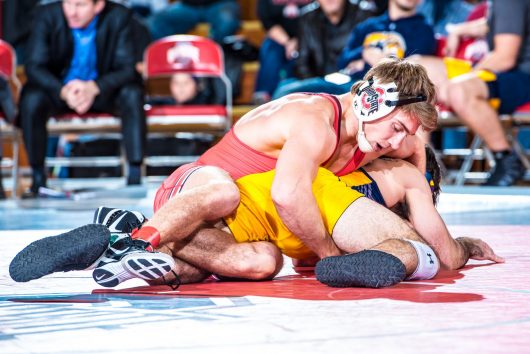
Ohio State wrestler sophomore Brendan Fitzgerald has competed unattached many times during his collegiate career. Courtesy of Sam Janicki
On most weekends, a large part of the Ohio State wrestling roster can be found competing on their own, with no coaches, not wearing Buckeye singlets in a small gym in front of minimal crowds. These wrestlers are competing unattached in open tournaments.
NCAA wrestling allows 16 dates of competition for Division I teams. Any event that has more than six competitors on a team counts as a full event. As a result, Ohio State pays for six or fewer nonstarters to compete at open events nearly every weekend. The wrestlers do not wear Ohio State-affiliated clothing and coaches rarely attend since it is not an official team event.
The true value of unattached events for a wrestling team might come from the athletes that attend but do not have their expenses paid for by the university. Wrestlers in their redshirt year compete in opens as well, but must pay their own way. They find a way to compete while redshirting, unlike a football redshirt who must watch from the sidelines.
“There’s a formula that made these guys Ohio State recruitable, and part of that formula is you have to compete,” head coach Tom Ryan said. “We don’t make it mandatory but I think winners and guys that want to eventually be starters and have a really successful redshirt year just have to compete.”

OSU redshirt freshman Kevin Snyder controls the hands of Cleveland State
sophomore Collin Kelly in a match on November 21, 2017 in Columbus, OH. Credit: Colin Barringer | For The Lantern
Ryan encourages his unattached wrestlers to attend any competition that takes place within a five-hour drive from Columbus. Ohio State wrestlers have competed in events like the Michigan State Open, the Eastern Michigan Open and the Purple Raider Open in Alliance, Ohio.
Competing unattached is a right of passage in the Buckeye wrestling room.
“More often than not, you need a year in a college room to be hardened and it’s like driving on the interstate versus driving on the autobahn,” Ryan said. “High school wrestling is the interstate or a residential neighborhood and college wrestling is the autobahn.”
While attending open meets, unattached wrestlers often carpool to the events and stay in hotel rooms together. They eat together and coach each other from the corner while wrestling. Redshirt freshman heavyweight Gary Traub has competed at multiple opens in his first two seasons, and has found that his best friendships on the team were forged on those trips.
“When I first got here, I didn’t know anybody,” Traub said. “So my first open, I’m like, ‘I want these guys to know that I belong here.’ I’m trying to do all this fancy stuff and these fancy moves and stuff like that just to show them that I belong because at first I really didn’t think I did.”
Open events bring much-needed experience to Ohio State wrestlers, but can pose a challenge for those who must pay their own way. Ryan estimates the cost of competing unattached for a season at around $900, accounting for food, travel and entrance expenses.
“That was tough,” Traub said. “I wanted to go to as many as I could, but there were a lot of times where [I said], ‘Damn, if I go I have to pay $40 for the entrance fee, I have to buy my own gas up there, I have to buy my own hotel.’ The cost of it was a big deterrent for a lot of the guys to go.”
The environments of open meets are less formal, which can allow for a looser attitude for competitors. However, less formality often comes with less regulation. An entrance fee is the only requirement to compete at most meets. As a result, the Ohio State wrestlers have seen some interesting things.
Redshirt freshman heavyweight Kevin Snyder saw a wrestler he estimated to be in his late 20s earlier this month. Snyder also added he’s seen a lot of heavyweights pushing the 285-pound limit. Sophomore Brendan Fitzgerald watched a wrestler lose a match, then slam his head on the ground.
“I feel like I wouldn’t see that at one of our meets or at a tournament that we’d go to,” he said. “I don’t think a coach would allow that.”
Traub recalled a weekend where a couple of his friends from high school found out that he would be competing in an open.
“They wanted to wrestle me so they literally just signed up for it and wrestled unattached, which was pretty funny,” Traub said. “That’s probably the weirdest thing I’ve seen, but it was a lot of fun.”
The stories that come from the unattached trips seem to be more memorable for the Buckeye wrestlers than the matches themselves. Snyder reflected fondly on packing into redshirt junior Anthony DiCarlo’s dad’s RV and traveling to meets. Traub remembers saving money by staying at redshirt freshman Clay Ragon’s house when entering meets up north.
For every high-profile Ohio State wrestling match at a Big Ten tournament or at the NCAA championships, there is an open match or a story from the journey to compete unattached on the other side of the spectrum. This is the side of collegiate wrestling that isn’t seen on the surface.
“I can see it makes sense from an outsider’s perspective,” Ryan said. “What do you mean he’s wrestling here and he’s not in an Ohio State singlet? It’s a little different, but in the wrestling world for recruits, prospects coming in, it’s the norm.”


